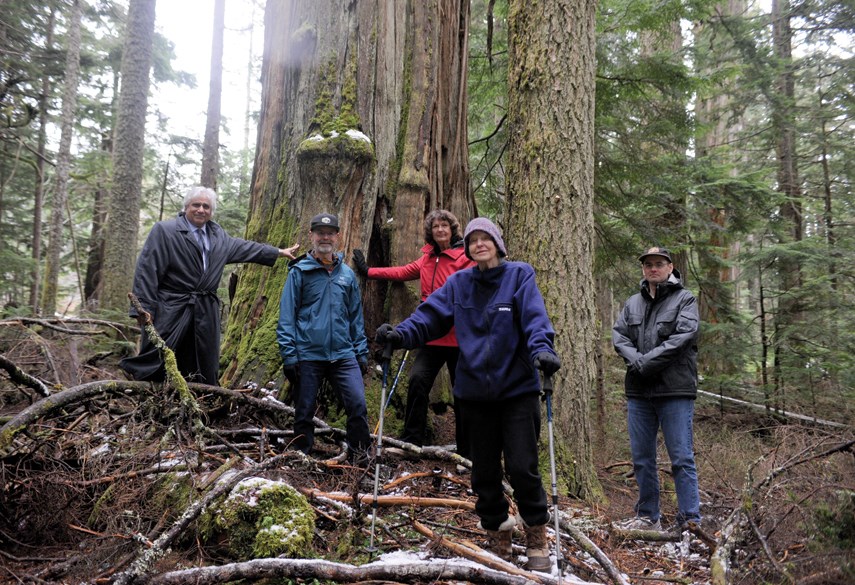By the time the public found out, it was all but a done deal.
In the spring of 1990, West Vancouver council was just a couple votes away from clear cutting up to 140-hectares of municipally owned land on Hollyburn Mountain, and leasing it out to a developer who would turn it into a 27-hole golf course. It would have destroyed one of the last stands of old growth cedars on the North Shore, some of which had been rooted in the soil for upwards of 900 years.
“They were determined to go ahead,” said Paul Hundal, a West Vancouver lawyer and environmental activist. “By July of that year, everything was done as far as council was concerned. All they had to do was sign the final contract with the developer.”
Hundal had hiked the local mountains since he was a young boy. He was shocked that anyone would consider chopping down trees so massive and so ancient.
“Yet, it is so accessible to the public that I can go in with my suit,” he said.
The developer offered to tag and save the oldest trees, or leave a portion up to nine hectares untouched, but Hundal argued that would still fragment and threaten their sensitive, irreplaceable niche, which allows for a kind of biodiversity not supported anywhere else. The West Coast would once have been blanketed with stands of trees, many hundreds of years old.
“That's where you can find the mosses and lichens and the old growth-dependent features that that still exist. It's one of the last places. If a spotted owl was flying over there, that's where it would stop,” Hundal said. “This becomes more and more important over time, because it's a perfect remnant of what these forests have looked like for thousands of years before the settlers came.”
Hundal co-founded Friends of Cypress to push back against the proposal. Grasping for a strategy, he searched the land title documents and found a covenant on two lots stating they were to remain for recreational purposes, which meant, under provincial law, if the land were to be leased for more than five years, it would have to be first approved via a referendum.
“It changed everything,” he said. “When I saw that, I immediately realized what we needed to do.”
The only legal workaround was if the district were to get an order-in-council signed by the premier to remove the covenant from the land. A call to Victoria confirmed then-mayor Donald Lanskail and senior staff were seeking just that. Hundal blew the whistle and Friends of Cypress started a letter writing campaign, urging Premier Bill Vander Zalm not to sign the order.
Within a few weeks, the once adamant West Van council relented and agreed to put the golf course proposal to a referendum.
Hundal remembers it being a highly divisive time in the community. Old growth supporters were labeled as “outside rabble rousers.”
“Well, it was terrible. It was ugly,” Hundal said.
When it came time for the Nov. 17 vote, Hundal said he was by no means assured his side had won. Throughout the public debates leading up to the referendum, it was a common theme for people on both sides to claim they were speaking for the silent majority.
When the results came in, 57 per cent said "No" to a golf course.
“One of the great, best moments of my life,” Hundal said.
More than 30 years later, Hundal said he hopes some of the golf course proponents have come around and would agree now it was the right decision.
“It's very important for the public to know now that this was saved and it's available for them to see, and we are taking school kids through there,” he said.
The golf proposal was vanquished but it still wasn’t entirely clear what to do with the land. It was becoming increasingly popular with mountain bikers and rogue trails were popping up.
In 2006, council wanted a longer-term strategy to protect the area, and sought the formation of society of stakeholders in the area. That gave rise to today’s West Vancouver Old Growth Conservancy and the non-profit society that oversees it.
Society secretary Alan Bardsley cast his No vote in the 1990 referendum, largely because he enjoyed using the area’s trails for mountain biking.
Therein lies the paradox of the Old Growth Conservancy Society, who are tasked with protecting the land but also ensuring the wider public appreciates why it is so special. For the first time, conservationists and recreationists came together as natural allies “because both want the same thing – keep the mountainside green,” Bardsley said.
“We incorporated the society with that balanced purpose of keep people out and bring them in,” he said. “It keeps us from swinging to one extreme or the other.”
During the summer months, they offer tours to anyone who wants to learn more about the rare stand. Bardsley said there’s always a moment of shock when they move from the old growth to the second growth stands of trees. In second growth areas, all the trees are roughly the same age and roughly the same height and the canopy is like a ceiling, which inhibits most everything else from growing on the forest floor.
There has never been a full inventory of the surviving old growth trees in the area, but Bardsley estimates there are between 100 and 200.
To mark the anniversary of the referendum, a group of about 40 turned up on the mountain Sunday to swap stories. Hundal wrote a short history of the struggle.
The group intended to hold a ceremony last year for the 30th anniversary of the referendum, but COVID-19 public health orders forced them to delay until the 31st. Call it a bogey.



